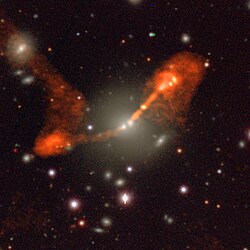Astronomy:NGC 326
| NGC 326 | |
|---|---|
 NGC 326 with DECam and with the Very Large Array radio sky survey called VLASS (orange part) | |
| Observation data (J2000 epoch) | |
| Constellation | Pisces |
| Right ascension | 00h 58m 22.7s[1] |
| Declination | +26° 51′ 55″[1] |
| Redshift | 0.047400[1] |
| Helio radial velocity | 14,210 km/s[1] |
| Apparent magnitude (V) | 14.33[1] |
| Characteristics | |
| Type | E |
| Apparent size (V) | 1.4' × 1.4'[1] |
| Other designations | |
| UGC 00601, CGCG 480-026, MCG +04-03-025, 4C +26.03, B2 0055+26, PGC 3326, PKS B0055+265, TXS 0055+265.[1] | |
NGC 326 is a dumbbell galaxy in the constellation Pisces. It was discovered on August 24, 1865 by Heinrich d'Arrest. It was described by Dreyer as "faint, a little extended, 9th or 10th magnitude star to southeast."[2]
Background
X-shaped (or "winged") radio galaxies are a class of extragalactic radio source that exhibit two, low-surface-brightness radio lobes (the "wings") oriented at an angle to the active, or high-surface-brightness, lobes. Both sets of lobes pass symmetrically through the center of the elliptical galaxy that is the source of the lobes, giving the radio galaxy an X-shaped morphology as seen on radio maps.[3]
Study of the galaxy
NGC 326 is a radio galaxy; in fact, it is one of the most prominent X-shaped galaxies ever observed. Several studies have been conducted to try to explain its morphology through either fluid motion or reorientation of the jet axis. The Chandra X-ray Observatory examined the emissions of the galaxy. The study revealed several features, including a high-temperature front that might indicate a shock, high-temperate knots around the rim of the radio emission, and a cavity associated with the eastern wing.[3][4]
References
- ↑ 1.0 1.1 1.2 1.3 1.4 1.5 1.6 "NASA/IPAC Extragalactic Database". Results for NGC 0326. http://ned.ipac.caltech.edu/cgi-bin/objsearch?objname=NGC+326&extend=no&hconst=73&omegam=0.27&omegav=0.73&corr_z=1&out_csys=Equatorial&out_equinox=J2000.0&obj_sort=RA+or+Longitude&of=pre_text&zv_breaker=30000.0&list_limit=5&img_stamp=YES.
- ↑ "New General Catalog Objects: NGC 300 - 349". Cseligman. http://cseligman.com/text/atlas/ngc3.htm#326.
- ↑ 3.0 3.1 "Study of X-Shaped Radio Galaxy NGC 326 Shows Outburst History and Active Galactic Nucleus Feedback". Scitechdaily. February 6, 2012. http://scitechdaily.com/study-of-x-shaped-radio-galaxy-ngc-326-shows-outburst-history-and-active-galactic-nucleus-feedback/.
- ↑ Hodges-Kluck, Edmund; Reynolds, Christopher S (December 12, 2011). "A Chandra Study of the Radio Galaxy NGC 326: Wings, Outburst History, and AGN Feedback". The Astrophysical Journal 746 (2): 167. doi:10.1088/0004-637X/746/2/167. Bibcode: 2012ApJ...746..167H.
External links
 |

